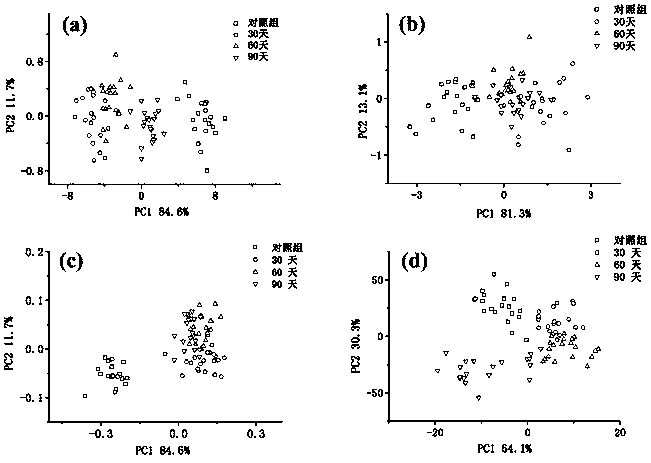Damage duration detection model of oriental arborvitae suffering from decayed dry pests based on electronic nose and application thereof
An electronic nose and orientalis technology, applied in the direction of material resistance, can solve the problems of inconspicuous early symptoms, economic and cultural losses, and the withering of orientalis trees.
Active Publication Date: 2019-04-16
ZHEJIANG UNIV
View PDF5 Cites 2 Cited by
- Summary
- Abstract
- Description
- Claims
- Application Information
AI Technical Summary
Problems solved by technology
Arborvitae stem borer pests often harm plants with poor growth or older trees. Since the stem borer pests spend most of their time inside the trunk, it is difficult to detect them by conventional methods, and the early symptoms after infection are not obvious, so it is easy to miss timely The timing of prevention and control will lead to the death of oriental cypress trees, resulting in reduced ornamental value, death of ancient trees, failure of afforestation, etc., resulting in great economic and cultural losses
Method used
the structure of the environmentally friendly knitted fabric provided by the present invention; figure 2 Flow chart of the yarn wrapping machine for environmentally friendly knitted fabrics and storage devices; image 3 Is the parameter map of the yarn covering machine
View moreImage
Smart Image Click on the blue labels to locate them in the text.
Smart ImageViewing Examples
Examples
Experimental program
Comparison scheme
Effect test
Embodiment
[0037] A method based on the electronic nose to quickly predict the length of time that Platycladus orientalis will be damaged by dry-boring pests. The steps are as follows:
the structure of the environmentally friendly knitted fabric provided by the present invention; figure 2 Flow chart of the yarn wrapping machine for environmentally friendly knitted fabrics and storage devices; image 3 Is the parameter map of the yarn covering machine
Login to View More PUM
 Login to View More
Login to View More Abstract
The invention discloses a damage duration detection model of an oriental arborvitae suffering from decayed dry pests based on an electronic nose and an application thereof. A field oriental arborvitaeis taken as a detected object, the oriental arborvitaes with similar growth vigor are selected to be grouped, and the same number of pests is inoculated for each sample group. After different damageperiods, the sample groups are standing in a headspace device for a period of time. The electronic nose is used to detect and the oriental arborvitae which is not inoculated with pests as a contrast group. A maximum value, a 75 second stable value, an integral value and a differential value are used to carry out characteristic extraction and comparison on obtained data, an optimal characteristic set is selected and the characteristic set is divided into a training set and a test set. A forward neural network model, a support vector machine and a probabilistic neural network are used to train the selected training set and a model with better classification effect on the test set is selected to predict the damage duration of the decayed dry pests. Operation is simple and a good prediction effect is possessed.
Description
Technical field [0001] The invention relates to a method for detecting the damage duration of the cypress in the wild, in particular to an electronic nose-based detection model for the duration of the cypress damaged by the dry pest and its application. Background technique [0002] Platycladus orientalis is widely planted in most areas of our country. It is an important afforestation and greening tree species with strong ornamental, cultural and medicinal value. Platycladus arborvitae stem-boring pests often damage arborvitae plants with poor growth or relatively high age. Because stem-boring pests spend most of their time inside the trunk, it is difficult to detect them by conventional methods, and their early symptoms after infection are not obvious. It is easy to miss timely The timing of prevention and control has led to the death of Platycladus orientalis trees, resulting in reduced ornamentation, death of ancient trees, failure of afforestation, etc., resulting in great ec...
Claims
the structure of the environmentally friendly knitted fabric provided by the present invention; figure 2 Flow chart of the yarn wrapping machine for environmentally friendly knitted fabrics and storage devices; image 3 Is the parameter map of the yarn covering machine
Login to View More Application Information
Patent Timeline
 Login to View More
Login to View More Patent Type & Authority Applications(China)
IPC IPC(8): G01N27/12
CPCG01N27/12
Inventor 王俊王阵贺
Owner ZHEJIANG UNIV
Features
- R&D
- Intellectual Property
- Life Sciences
- Materials
- Tech Scout
Why Patsnap Eureka
- Unparalleled Data Quality
- Higher Quality Content
- 60% Fewer Hallucinations
Social media
Patsnap Eureka Blog
Learn More Browse by: Latest US Patents, China's latest patents, Technical Efficacy Thesaurus, Application Domain, Technology Topic, Popular Technical Reports.
© 2025 PatSnap. All rights reserved.Legal|Privacy policy|Modern Slavery Act Transparency Statement|Sitemap|About US| Contact US: help@patsnap.com



